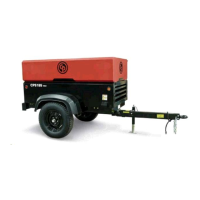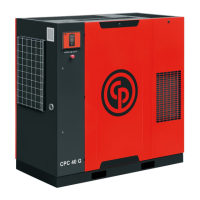Do you have a question about the Chicago Pneumatic CPS 750 and is the answer not in the manual?
Introduction to the manual and general advice for safe operation of the compressor.
Chicago Pneumatic's commitment to providing safe, reliable, and efficient products.
Essential safety rules and responsibilities for the owner and operator.
Guidelines for safely moving and setting up the compressor unit.
Critical safety measures for operating the compressor under various conditions.
Procedures and precautions for safe servicing and repair of the unit.
Guidelines for safe and effective use of tools during maintenance.
Detailed safety advice for specific components like batteries.
Overview of the CPS 750 compressor's design and capabilities.
Explanation of various symbols and labels found on the unit.
Diagram and list identifying key components of the compressor.
Description of the compressor's regulating system and its functions.
Detailed explanation of the air path through the compressor.
Explanation of the compressor's lubrication and oil system.
Details on how the continuous regulating system manages air output.
Circuit diagram and identification of electrical components.
Guidelines for safely parking the compressor unit.
Procedures and safety measures for towing the compressor.
Safe methods and precautions for lifting the compressor.
Essential checks and preparations before initial compressor startup.
Overview of the procedures for starting and stopping the compressor.
Explanation of the control panel layout and its buttons.
Regular checks to perform while the compressor is running.
Steps for turning the compressor on and off.
Detailed steps for starting the compressor engine.
Procedure for warming up the engine before loading the compressor.
Steps to engage the compressor and reach working pressure.
Safe steps for shutting down the compressor.
Parameters that trigger an automatic shutdown of the unit.
How to use the emergency stop and interpret warnings.
Manufacturer's disclaimer regarding non-original parts and modifications.
Details on service packs and kits for maintenance tasks.
Instructions for proper storage of the compressor.
Recommended maintenance intervals and tasks.
Recommended types and grades of oil for the compressor and engine.
Specifics on synthetic and mineral compressor oils.
Details on GENOIL synthetic and mineral engine oils.
Procedures for checking engine and compressor oil levels.
Steps for changing engine and compressor oil and filters.
Procedure for changing engine oil and its filter.
Procedure for changing compressor oil and its filter.
Instructions for adding oil to the compressor.
Requirements and recommendations for engine coolant.
Information on GENCOOL EG coolant, its properties and part numbers.
Guidelines for storing and using GENCOOL EG coolant.
Methods for checking coolant condition: visual, pH, and concentration.
Procedures for adding or replacing the engine coolant.
Method for topping up coolant without draining the system.
Method for topping up coolant after partial draining.
Steps for completely draining, flushing, and refilling the cooling system.
Instructions for cleaning oil, engine, and intercoolers.
Guidelines for safe handling and upkeep of the battery.
Safety precautions when handling battery electrolyte.
Procedure for activating a new dry-charged battery.
Instructions for safely recharging the battery.
Best practices for maintaining battery cleanliness and connections.
Procedure for setting the compressor's working pressure.
Information on servicing the engine and compressor air filters.
Diagram and list of the main parts of the air filter assembly.
Instructions for cleaning the dust trap on the air filter.
Procedure for replacing air filter elements and safety cartridges.
Guidelines for inspecting the air receiver according to standards.
Maintenance procedures for the fuel system.
Instructions for draining water and sediment from the fuel filter.
Procedure to fill the fuel filter and purge trapped air.
Steps for replacing AC and Caterpillar fuel filter elements.
Procedures for checking the safety valve's function.
Instructions for adjusting the compressor's brake system.
Detailed steps for adjusting the brake shoes.
Troubleshooting guide for low compressor capacity or pressure.
Diagnosing issues causing high receiver pressure or safety valve activation.
Identifying causes for unexpected unit shutdowns.
Troubleshooting air and oil mist exiting filters after shutdown.
Identifying and resolving causes of compressor overheating.
Safety measures related to the alternator and battery connections.
Options for mounting the unit on trucks or using forklifts.
Different types of towbars and towing eyes available.
Options designed for operation in low-temperature environments.
Options for improving air quality and temperature.
Options for dry air and exhaust safety.
Engine protection and specialized package options.
Options for customizing the unit's color scheme.
Recommended torque values for general and important assemblies.
Specified settings for shutdown switches and safety valves.
Standard conditions under which specifications are measured.
Maximum and minimum operating parameters for the compressor.
Graph showing performance variation with altitude and temperature.
Key performance metrics including air delivery, fuel consumption, and noise.
Technical details of the compressor element and engine.
Explanation of the information presented on the unit's dataplate.
Compliance with Directive 97/23/EC for pressure equipment.
Compliance with Directive 87/404/EC for simple pressure vessels.
Compliance with Directive 89/392/EC for machinery.
Compliance with specific regulatory articles.
Introduction to the manual and general advice for safe operation of the compressor.
Chicago Pneumatic's commitment to providing safe, reliable, and efficient products.
Essential safety rules and responsibilities for the owner and operator.
Guidelines for safely moving and setting up the compressor unit.
Critical safety measures for operating the compressor under various conditions.
Procedures and precautions for safe servicing and repair of the unit.
Guidelines for safe and effective use of tools during maintenance.
Detailed safety advice for specific components like batteries.
Overview of the CPS 750 compressor's design and capabilities.
Explanation of various symbols and labels found on the unit.
Diagram and list identifying key components of the compressor.
Description of the compressor's regulating system and its functions.
Detailed explanation of the air path through the compressor.
Explanation of the compressor's lubrication and oil system.
Details on how the continuous regulating system manages air output.
Circuit diagram and identification of electrical components.
Guidelines for safely parking the compressor unit.
Procedures and safety measures for towing the compressor.
Safe methods and precautions for lifting the compressor.
Essential checks and preparations before initial compressor startup.
Overview of the procedures for starting and stopping the compressor.
Explanation of the control panel layout and its buttons.
Regular checks to perform while the compressor is running.
Steps for turning the compressor on and off.
Detailed steps for starting the compressor engine.
Procedure for warming up the engine before loading the compressor.
Steps to engage the compressor and reach working pressure.
Safe steps for shutting down the compressor.
Parameters that trigger an automatic shutdown of the unit.
How to use the emergency stop and interpret warnings.
Manufacturer's disclaimer regarding non-original parts and modifications.
Details on service packs and kits for maintenance tasks.
Instructions for proper storage of the compressor.
Recommended maintenance intervals and tasks.
Recommended types and grades of oil for the compressor and engine.
Specifics on synthetic and mineral compressor oils.
Details on GENOIL synthetic and mineral engine oils.
Procedures for checking engine and compressor oil levels.
Steps for changing engine and compressor oil and filters.
Procedure for changing engine oil and its filter.
Procedure for changing compressor oil and its filter.
Instructions for adding oil to the compressor.
Requirements and recommendations for engine coolant.
Information on GENCOOL EG coolant, its properties and part numbers.
Guidelines for storing and using GENCOOL EG coolant.
Methods for checking coolant condition: visual, pH, and concentration.
Procedures for adding or replacing the engine coolant.
Method for topping up coolant without draining the system.
Method for topping up coolant after partial draining.
Steps for completely draining, flushing, and refilling the cooling system.
Instructions for cleaning oil, engine, and intercoolers.
Guidelines for safe handling and upkeep of the battery.
Safety precautions when handling battery electrolyte.
Procedure for activating a new dry-charged battery.
Instructions for safely recharging the battery.
Best practices for maintaining battery cleanliness and connections.
Procedure for setting the compressor's working pressure.
Information on servicing the engine and compressor air filters.
Diagram and list of the main parts of the air filter assembly.
Instructions for cleaning the dust trap on the air filter.
Procedure for replacing air filter elements and safety cartridges.
Guidelines for inspecting the air receiver according to standards.
Maintenance procedures for the fuel system.
Instructions for draining water and sediment from the fuel filter.
Procedure to fill the fuel filter and purge trapped air.
Steps for replacing AC and Caterpillar fuel filter elements.
Procedures for checking the safety valve's function.
Instructions for adjusting the compressor's brake system.
Detailed steps for adjusting the brake shoes.
Troubleshooting guide for low compressor capacity or pressure.
Diagnosing issues causing high receiver pressure or safety valve activation.
Identifying causes for unexpected unit shutdowns.
Troubleshooting air and oil mist exiting filters after shutdown.
Identifying and resolving causes of compressor overheating.
Safety measures related to the alternator and battery connections.
Options for mounting the unit on trucks or using forklifts.
Different types of towbars and towing eyes available.
Options designed for operation in low-temperature environments.
Options for improving air quality and temperature.
Options for dry air and exhaust safety.
Engine protection and specialized package options.
Options for customizing the unit's color scheme.
Recommended torque values for general and important assemblies.
Specified settings for shutdown switches and safety valves.
Standard conditions under which specifications are measured.
Maximum and minimum operating parameters for the compressor.
Graph showing performance variation with altitude and temperature.
Key performance metrics including air delivery, fuel consumption, and noise.
Technical details of the compressor element and engine.
Explanation of the information presented on the unit's dataplate.
Compliance with Directive 97/23/EC for pressure equipment.
Compliance with Directive 87/404/EC for simple pressure vessels.
Compliance with Directive 89/392/EC for machinery.
Compliance with specific regulatory articles.
| Brand | Chicago Pneumatic |
|---|---|
| Model | CPS 750 |
| Category | Air Compressor |
| Language | English |











